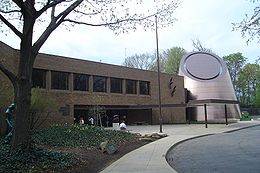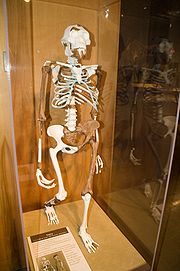
Cleveland Museum of Natural History
Encyclopedia


Natural history
Natural history is the scientific research of plants or animals, leaning more towards observational rather than experimental methods of study, and encompasses more research published in magazines than in academic journals. Grouped among the natural sciences, natural history is the systematic study...
museum
Museum
A museum is an institution that cares for a collection of artifacts and other objects of scientific, artistic, cultural, or historical importance and makes them available for public viewing through exhibits that may be permanent or temporary. Most large museums are located in major cities...
located approximately five miles (8 km) east of downtown Cleveland, Ohio
Cleveland, Ohio
Cleveland is a city in the U.S. state of Ohio and is the county seat of Cuyahoga County, the most populous county in the state. The city is located in northeastern Ohio on the southern shore of Lake Erie, approximately west of the Pennsylvania border...
in University Circle
University Circle
University Circle, is a neighborhood located on the east side of Cleveland, Ohio. It is best known for its world-class cultural, educational and medical institutions, including the Cleveland Orchestra, Case Western Reserve University, Cleveland Museum of Art, Lakeview Cemetery, and University...
, a 550-acre (220 ha) concentration of educational, cultural and medical institutions. The museum was established in 1920 to perform research, education and development of collections in the fields of anthropology
Anthropology
Anthropology is the study of humanity. It has origins in the humanities, the natural sciences, and the social sciences. The term "anthropology" is from the Greek anthrōpos , "man", understood to mean mankind or humanity, and -logia , "discourse" or "study", and was first used in 1501 by German...
, archaeology
Archaeology
Archaeology, or archeology , is the study of human society, primarily through the recovery and analysis of the material culture and environmental data that they have left behind, which includes artifacts, architecture, biofacts and cultural landscapes...
, astronomy
Astronomy
Astronomy is a natural science that deals with the study of celestial objects and phenomena that originate outside the atmosphere of Earth...
, botany
Botany
Botany, plant science, or plant biology is a branch of biology that involves the scientific study of plant life. Traditionally, botany also included the study of fungi, algae and viruses...
, geology
Geology
Geology is the science comprising the study of solid Earth, the rocks of which it is composed, and the processes by which it evolves. Geology gives insight into the history of the Earth, as it provides the primary evidence for plate tectonics, the evolutionary history of life, and past climates...
, paleontology
Paleontology
Paleontology "old, ancient", ὄν, ὀντ- "being, creature", and λόγος "speech, thought") is the study of prehistoric life. It includes the study of fossils to determine organisms' evolution and interactions with each other and their environments...
, wildlife biology, and zoology
Zoology
Zoology |zoölogy]]), is the branch of biology that relates to the animal kingdom, including the structure, embryology, evolution, classification, habits, and distribution of all animals, both living and extinct...
.
Donald Johanson
Donald Johanson
Donald Carl Johanson is an American paleoanthropologist. Along with Maurice Taieb, and Yves Coppens he is known for the discovery of the skeleton of the female hominid australopithecine known as "Lucy", in the Afar Triangle region of Hadar, Ethiopia.-Early years:Johanson was born in Chicago,...
was the curator of the museum when he discovered "Lucy
Lucy (Australopithecus)
Lucy is the common name of AL 288-1, several hundred pieces of bone representing about 40% of the skeleton of an individual Australopithecus afarensis. The specimen was discovered in 1974 at Hadar in the Awash Valley of Ethiopia's Afar Depression. Lucy is estimated to have lived 3.2 million years...
," the skeletal remains of the ancient hominid
Hominidae
The Hominidae or include them .), as the term is used here, form a taxonomic family, including four extant genera: chimpanzees , gorillas , humans , and orangutans ....
Australopithecus afarensis
Australopithecus afarensis
Australopithecus afarensis is an extinct hominid that lived between 3.9 and 2.9 million years ago. A. afarensis was slenderly built, like the younger Australopithecus africanus. It is thought that A...
. The current Curator and Head of the Physical Anthropology Department is Yohannes Haile-Selassie
Yohannes Haile-Selassie
Dr. Yohannes Haile-Selassie is an Ethiopian paleoanthropologist. An authority on pre-Homo sapiens hominids, he particularly focuses his attention on the Great Rift Valley and Middle Awash Valleys of East Africa....
.
In 2002, the new Fannye Shafran Planetarium
Planetarium
A planetarium is a theatre built primarily for presenting educational and entertaining shows about astronomy and the night sky, or for training in celestial navigation...
was built near the entrance to the museum, containing displays on the planets in the Solar System, and historical instrument
Measuring instrument
In the physical sciences, quality assurance, and engineering, measurement is the activity of obtaining and comparing physical quantities of real-world objects and events. Established standard objects and events are used as units, and the process of measurement gives a number relating the item...
s of exploration, such as compass
Compass
A compass is a navigational instrument that shows directions in a frame of reference that is stationary relative to the surface of the earth. The frame of reference defines the four cardinal directions – north, south, east, and west. Intermediate directions are also defined...
es and astrolabe
Astrolabe
An astrolabe is an elaborate inclinometer, historically used by astronomers, navigators, and astrologers. Its many uses include locating and predicting the positions of the Sun, Moon, planets, and stars, determining local time given local latitude and longitude, surveying, triangulation, and to...
s.
Exhibits

Mineralogy
Mineralogy is the study of chemistry, crystal structure, and physical properties of minerals. Specific studies within mineralogy include the processes of mineral origin and formation, classification of minerals, their geographical distribution, as well as their utilization.-History:Early writing...
, ornithology, and a variety of other scientific subjects.
A beloved full-scale model of a stegosaurus
Stegosaurus
Stegosaurus is a genus of armored stegosaurid dinosaur. They lived during the Late Jurassic period , some 155 to 150 million years ago in what is now western North America. In 2006, a specimen of Stegosaurus was announced from Portugal, showing that they were present in Europe as well...
on the lawn delights Cleveland children.
Some of the more important specimens include:
- Extensive examples of Late DevonianDevonianThe Devonian is a geologic period and system of the Paleozoic Era spanning from the end of the Silurian Period, about 416.0 ± 2.8 Mya , to the beginning of the Carboniferous Period, about 359.2 ± 2.5 Mya...
Cleveland Shale fish. - Nine hundred monkeyMonkeyA monkey is a primate, either an Old World monkey or a New World monkey. There are about 260 known living species of monkey. Many are arboreal, although there are species that live primarily on the ground, such as baboons. Monkeys are generally considered to be intelligent. Unlike apes, monkeys...
and apeApeApes are Old World anthropoid mammals, more specifically a clade of tailless catarrhine primates, belonging to the biological superfamily Hominoidea. The apes are native to Africa and South-east Asia, although in relatively recent times humans have spread all over the world...
skeletons, and more than 3,100 human skeletons (the Hamann-Todd Collection). - The only specimen of the small tyrannosaurTyrannosauridaeTyrannosauridae is a family of coelurosaurian theropod dinosaurs which comprises two subfamilies containing up to six genera, including the eponymous Tyrannosaurus. The exact number of genera is controversial, with some experts recognizing as few as three...
Nanotyrannus lancensis. - The holotypeHolotypeA holotype is a single physical example of an organism, known to have been used when the species was formally described. It is either the single such physical example or one of several such, but explicitly designated as the holotype...
of the HaplocanthosaurusHaplocanthosaurusHaplocanthosaurus is a genus of sauropod dinosaur. Two species, H. delfsi and H. priscus, are known from incomplete fossil skeletons. It lived during the late Jurassic period , 155 to 152 million years ago. The type species is H. priscus, and the referred species H...
sauropodSauropodaSauropoda , or the sauropods , are an infraorder of saurischian dinosaurs. They had long necks, long tails, small heads , and thick, pillar-like legs. They are notable for the enormous sizes attained by some species, and the group includes the largest animals to have ever lived on land...
. - The most complete mount of a Coelophysis bauriCoelophysisCoelophysis , meaning "hollow form" in reference to its hollow bones , is one of the earliest known genera of dinosaur...
. - The remains of BaltoBaltoBalto was a Siberian Husky sled dog who led his team on the final leg of the 1925 serum run to Nome, in which diphtheria antitoxin was transported from Anchorage, Alaska, to Nenana, Alaska, by train and then to Nome by dog sled to combat an outbreak of the disease. The run is commemorated by the...
the sled dogSled dogSled dogs, known also as sleigh man dogs, sledge dogs, or sleddogs, are highly trained types of dogs that are used to pull a dog sled, a wheel-less vehicle on runners also called a sled or sleigh, over snow or ice, by means of harnesses and lines.Sled dogs have become a popular winter recreation...
. - An extensive mineralogy collection that includes a moon rockMoon rockMoon rock describes rock that formed on the Earth's moon. The term is also loosely applied to other lunar materials collected during the course of human exploration of the Moon.The rocks collected from the Moon are measured by radiometric dating techniques...
and the Jeptha WadeJeptha WadeJeptha Homer Wade was an American industrialist, philanthropist, and one of the founding members of Western Union Telegraph....
gemGemstoneA gemstone or gem is a piece of mineral, which, in cut and polished form, is used to make jewelry or other adornments...
collection. - Replica skeletons of Triceratops and Jane, a juvenile tyrannosaurid.
- Multiple mastodon and mammoth specimens.
- A cast of an Australopithecus afarensisAustralopithecus afarensisAustralopithecus afarensis is an extinct hominid that lived between 3.9 and 2.9 million years ago. A. afarensis was slenderly built, like the younger Australopithecus africanus. It is thought that A...
skeleton, an early hominid affectionately dubbed LucyLucy (Australopithecus)Lucy is the common name of AL 288-1, several hundred pieces of bone representing about 40% of the skeleton of an individual Australopithecus afarensis. The specimen was discovered in 1974 at Hadar in the Awash Valley of Ethiopia's Afar Depression. Lucy is estimated to have lived 3.2 million years...
. - A new T-rex skeleton that is now on display.
The museum has made many discoveries over the years. Recently, in Vertebrate Paleontology, both the remains of a Titanicthis in Ohio and a new ceratopsian, Albertaceratops nesmoi, have been made. Both are expected to go on display eventually.
Hamann-Todd Collection
The Hamann-Todd Collection is a collection of more than 3100 human skeletonSkeleton
The skeleton is the body part that forms the supporting structure of an organism. There are two different skeletal types: the exoskeleton, which is the stable outer shell of an organism, and the endoskeleton, which forms the support structure inside the body.In a figurative sense, skeleton can...
s and over 900 primate skeletons that were assembled starting in 1893. The collection was originally housed in Western Reserve University Medical School; in a new medical building that was built. The first floor of this building contained the Hamann Museum of Comparative Anthropology and Anatomy. However, due to the costs of storing the bones, the collection was transferred to the Cleveland Museum of Natural History.
The collection was started by Carl August Hamann. Its administration was taken over by T. Wingate Todd after Hamann was named dean of Case Western's medical school. Todd managed to assemble the great majority of the human skeletons in the collection, over 3000, before his death in 1938.

